SMA to BNC Adapter Guide: Types, Gender Codes & 50/75 Ω Tips
Sep 02,2025
Introduction
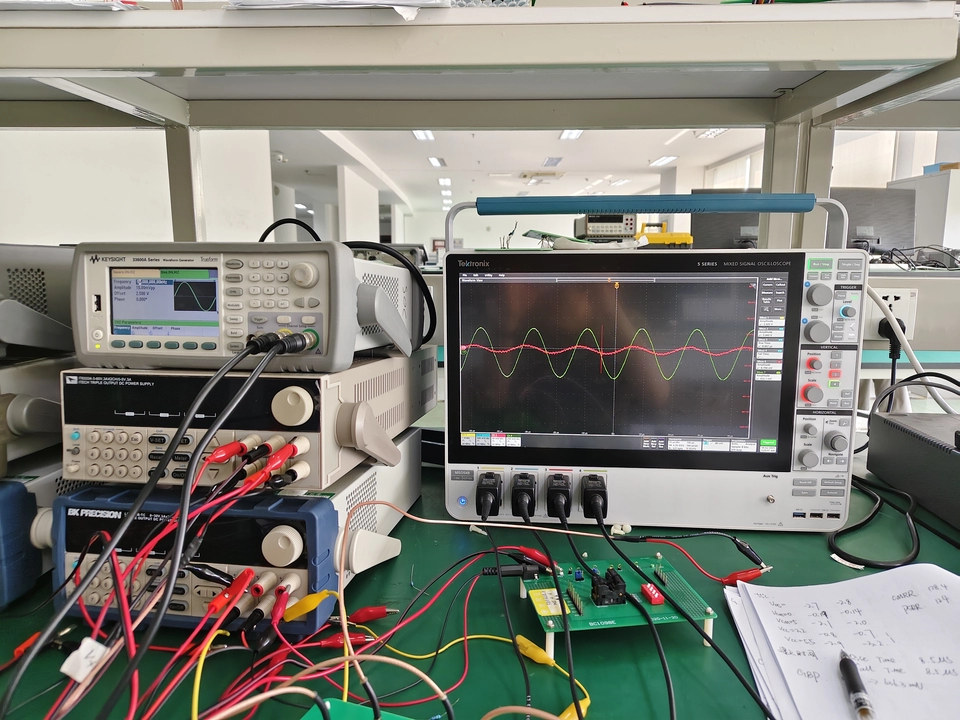
This introductory image sets the stage for the guide by depicting a real-world application of the SMA to BNC adapter. It shows the adapter fulfilling its primary role: acting as a mechanical and RF bridge between two different connector standards found in common engineering environments like electronics labs. It emphasizes the adapter's practicality and widespread use without delving into technical specifics yet.
Walk into a busy RF lab, set up an SDR on your desk, or check the back of a CCTV capture card—you’ll almost always spot an SMA to BNC adapter. It’s the quiet bridge between two very different connector families: the threaded SMA and the bayonet-style BNC.
What it does is simple: allow signals to pass smoothly without forcing you to replace cables or redesign a setup. But don’t mistake it for an HDMI, USB, or Ethernet converter. Nothing digital is being translated here. It’s purely a mechanical and RF interface match.
Here’s the catch: performance depends on details. Pick the right gender (male or female), match the correct impedance (50 Ω vs 75 Ω), and keep adapters in series to a minimum. Do that, and you’ll get low loss and a stable VSWR. Ignore those basics, and you’ll likely end up chasing reflections on your oscilloscope or troubleshooting unnecessary signal dropouts.
A quick tip from real-world use: if you’re testing sensitive receivers, even one poorly chosen adapter can throw off your readings. That’s why engineers often keep a small kit of SMA↔BNC adapters in different genders and impedances, ready to swap in when the setup demands it.
1) What Is an SMA↔BNC Adapter?
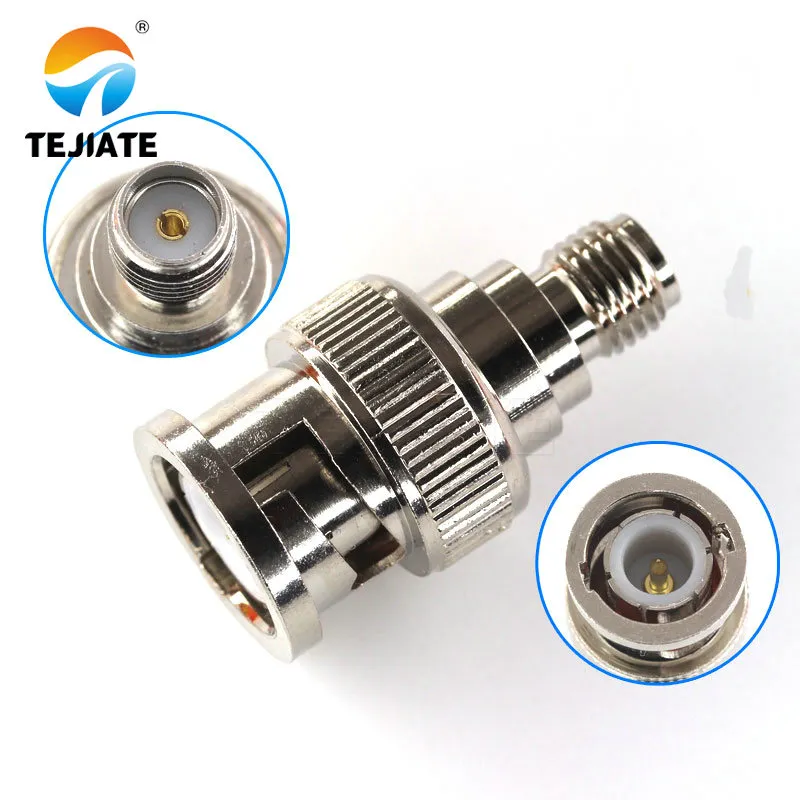
This image provides a clear, focused look at the physical adapter unit discussed in the section. It allows the reader to visualize the key components: the SMA end (likely male, with internal threads and a center pin) and the BNC end (likely female, with a bayonet coupling mechanism and center socket). This visual definition complements the text explaining the adapter's fundamental purpose as a detachable coaxial transition.
An SMA↔BNC adapter is a detachable coaxial transition that lets threaded SMA connectors link directly with bayonet-style BNC connectors. At first glance, it’s just a small metal piece, but in practice it saves enormous time. Instead of cutting and re-terminating coax, you simply twist on the adapter and you’re ready to measure or transmit.
You’ll see it used almost everywhere:
- Oscilloscopes and spectrum analyzers typically ship with BNC inputs, while test probes and antennas are more often SMA.
- SDR (Software Defined Radios) use SMA as a standard, but many lab accessories—attenuators, filters, even coax jumpers—still favor BNC.
- CCTV capture cards and monitoring equipment rely on BNC coax, yet may need to link with SMA-based RF front-ends.
- Amateur radio and IoT modules, where antennas are swapped frequently, often depend on these small adapters to keep experiments moving.
It’s important to draw a line between a solid metal adapter and a flexible adapter cable (pigtail). The rigid adapter works well on a test bench or in stable gear. But if you’re fighting tight rack space or mechanical stress, a short coax jumper—say RG178 or RG316—is the safer option. I’ve seen engineers crack board-mounted SMA connectors by forcing a rigid adapter where a pigtail would have absorbed the strain.
From TEJTE’s tested designs, typical SMA adapters share reliable specs:
- Operating temperature: –65 °C to +165 °C (PE cables rated –40 °C to +85 °C)
- Working voltage: up to 335 V
- Frequency range: DC–12.4 GHz, with some models pushing 18 GHz
- VSWR: ≤1.20 from 0–3 GHz, ≤1.30 up to 6 GHz
- Durability: 500+ cycles for brass versions, more than 1000 cycles for stainless steel
A practical note: TEJTE’s SMA-JJ adapter (inner thread, pin-to-pin) is rated for ≤0.15 dB insertion loss at 6 GHz and over 1000 mating cycles. Numbers like that explain why these tiny parts are trusted in both precision labs and rugged field systems.
2) Identify Genders: SMA vs BNC (Avoid Buying the Wrong Part)
Ordering the wrong adapter happens more often than you’d think. Both SMA and BNC use the terms male and female, but the definitions don’t always line up intuitively. Add in the difference between cable ends and panel mounts, and confusion is almost guaranteed.
SMA gender basics:
- SMA male adapter → external thread with a center pin.
- SMA female → internal thread with a center socket.
In TEJTE’s catalog, you’ll find variations like:
- SMA-JJ: inner thread, pin-to-pin coupler.
- SMA-KK: outer thread, socket-to-socket.
- SMA-JK: outer thread, pin-to-socket.
- SMA-KKY: bulkhead version, 22 mm long with a screw nut for panel installs.
BNC gender basics:
- BNC plug (male) → bayonet housing with a protruding pin.
- BNC jack (female) → bayonet housing with a socket.
A quick field check can save you from mistakes: cables almost always terminate in male plugs, while panels and equipment housings usually present female jacks. If you keep that rule of thumb in mind, you won’t waste money buying a BNC male to SMA male when what you really needed was a BNC female to SMA male.
From my own bench work: having both couplers and gender changers on hand makes troubleshooting much faster. More than once, a forgotten SMA male-to-female adapter was the missing piece that got a measurement session back on track.
3) SMA to BNC Adapter Plug/Jack Combinations

This image is a crucial reference tool within the guide. It visually summarizes the six core adapter types based on gender (male/female) combinations between SMA and BNC interfaces. This helps users quickly identify which physical adapter they need to connect their specific equipment (e.g., SMA male cable to BNC female instrument port, or SMA female device to BNC male cable). It directly supports the detailed table and text describing each combination's typical use case.
In the real world, no single adapter covers all scenarios. The SMA to BNC adapter family comes in a handful of practical combinations, and knowing the right one up front saves both time and frustration.
Here are the six you’ll see most often:
- SMA-male → BNC-female: The classic lab setup, bridging an SMA test antenna to a spectrum analyzer’s BNC port.
- SMA-female → BNC-male: Used when you need to link an SMA-based device directly into a BNC coax line.
- SMA-male → BNC-male: Handy when both devices expose female jacks.
- SMA-female → BNC-female (coupler): Perfect for extending or bridging two cables.
- BNC-male → SMA-female: Common in CCTV retrofits where old coax systems meet newer RF modules.
- BNC-female → SMA-male: Lets you adapt a chassis BNC port to an SMA antenna or cable.
Beyond these six, there are specialized forms worth mentioning:
- Right-angle adapters, like TEJTE’s SMA-JWK or SMA-KWK, which make life easier when clearance inside enclosures is tight. They maintain ≤0.15 dB insertion loss at 6 GHz and can survive over 1000 connections.
- Bulkhead/panel-mount types, such as SMA-KKY, designed with a 22 mm body and screw nut to secure through metal panels—ideal for rack systems or sealed housings.
- Extended or shortened bodies, which provide extra clearance depending on your mechanical layout.
| Combination | Typical Use Case | Notes |
|---|---|---|
| SMA-male → BNC-female | Spectrum analyzer, oscilloscope | Most common lab setup |
| SMA-female → BNC-male | SDR dongles → BNC coax | Handy for radio/SDR users |
| SMA-male → BNC-male | Linking two female jacks | Less frequent, but useful |
| SMA-female → BNC-female | Cable extension, coupler | Good for quick fixes |
| BNC-male → SMA-female | CCTV upgrades | Legacy system integration |
| BNC-female → SMA-male | Adapting panels → SMA antenna | Useful in enclosures |
3) SMA to BNC Adapter Plug/Jack Combinations
- JWK/KWK = right-angle types, handy in tight spaces.
- SMA to Pin / quick-connect = for test jigs and fast swaps.
In everyday talk, these are simply “sma gender changers.” A JJ lets two female ports mate, KK links two males, and JK/KJ handle the mixed cases. More than one engineer has ordered the wrong part by overlooking this code—learning it once saves both time and budget.
4) 50 Ω vs 75 Ω: When It Matters
Impedance is where many beginners get caught off guard. With SMA connectors, things are straightforward—they are almost always 50 ohm. But BNC adapters come in two flavors: 50 Ω for RF and data systems, and 75 Ω for video or broadcast chains.
So, when does it matter?
- If you’re working on short, low-frequency runs—say under 100 MHz and less than a meter—mixing a 50 ohm SMA adapter with a 75 ohm BNC adapter usually won’t ruin your signal. The mismatch creates only minor reflections.
- On the other hand, for video applications (75 Ω) or precision RF measurements, impedance must match. A 50 ↔ 75 ohm BNC adapter mismatch at higher frequencies can mean visible distortion, higher bit error rates, or inaccurate readings on your test gear.
To put real numbers on it: TEJTE’s SMA coax adapters specify VSWR ≤1.20 from 0–3 GHz and ≤1.30 up to 6 GHz. Those figures assume correct impedance. Connect them across a mismatch, and insertion loss plus reflection will climb—sometimes enough to derail a clean measurement above 1 GHz.
| Parameter | 50 Ω BNC/SMA | 75 Ω BNC | Impact if mismatched |
|---|---|---|---|
| Standard use | RF, wireless, data | Video, broadcast | Reflection, higher VSWR |
| Frequency tolerance | Up to 18 GHz | Generally < 3 GHz | Loss increases with frequency |
| Typical system | Lab instruments, SDR | CCTV, TV monitors | Errors in precision tests |
| Safe to mix? | Only short runs < 1 m at low frequency | Not recommended above 1 GHz | |
Quick troubleshooting checklist:
- Confirm whether your BNC connector is 50 Ω or 75 Ω (it’s often labeled or in the datasheet).
- If a mismatch is unavoidable, use a 50 ohm to 75 ohm BNC adapter specifically designed for impedance conversion—not a plain coupler.
- Watch your oscilloscope traces or BER counters; they’ll tell you faster than specs whether impedance is the culprit.
From field experience: if a video monitor shows ghosting or a lab sweep displays ripples, nine times out of ten it’s an impedance mismatch. Swapping in the right 75 ohm BNC adapter fixes it immediately.
5) RF Considerations: Frequency, VSWR & Insertion Loss
Every adapter adds a little penalty. The golden rule in RF work is simple: use as few adapters as possible. Each extra piece brings a touch more loss and a small increase in reflection.
- Insertion loss: TEJTE’s SMA coax adapter series keeps it low, typically ≤0.15 dB at 6 GHz. That sounds negligible, but stack two or three adapters together and the attenuation becomes noticeable—especially in weak-signal systems.
- VSWR effects: A single, well-made adapter maintains VSWR around 1.20, but several in series can push this number higher, leading to ripples in broadband sweeps. Engineers often see these ripples appear on a spectrum analyzer and know immediately they’ve chained too many adapters.
- High-frequency behavior: Right-angle designs (like SMA-JWK and SMA-KWK) are great for tight spaces. Still, they introduce slightly higher parasitic effects compared to straight adapters. Up to several GHz, that’s fine. But if you’re working above 12 GHz or even 18 GHz, a straight adapter is usually the safer bet.
- Material and plating: Brass bodies are cost-effective and perfectly adequate for many labs. Stainless steel versions, though, last longer—often surviving 1000+ mating cycles without loosening. Contacts are usually beryllium bronze with gold plating, giving stable conductivity and low contact resistance.
- Environmental resilience: Many TEJTE adapters are sealed with silicone rubber O-rings and rated for –65 °C to +165 °C operation. That makes them dependable in outdoor installations, from rooftop antennas to industrial enclosures.
A practical reminder: if you’re testing sensitive receivers like GNSS modules or SDR front-ends, even a 0.2 dB increase in loss can matter. In my own work, I keep premium stainless-steel adapters for high-frequency sweeps and use the standard brass ones for general bench setups. That way, the best gear is reserved for the toughest jobs.
TEJTE SMA↔BNC Adapter Specifications
| Model | Structure / Type | Impedance | Frequency Range | VSWR | Insertion Loss | Durability (cycles) | Notes / Applications |
|---|---|---|---|---|---|---|---|
| SMA-JJ | Inner thread, pin-to-pin | 50 Ω | DC–12.4 GHz | ≤1.20 @ 3 GHz ≤1.30 @ 6 GHz |
≤0.15 dB @ 6 GHz | ≥1000 (stainless) | Common lab coupler |
| SMA-KK | Outer thread, socket-to-socket | 50 Ω | DC–12.4 GHz | ≤1.20 / ≤1.30 | ≤0.15 dB @ 6 GHz | ≥500 (brass) | Gender changer |
| SMA-JK | Outer thread, pin-to-socket | 50 Ω | DC–12.4 GHz | ≤1.20 / ≤1.30 | ≤0.15 dB @ 6 GHz | ≥500 | Basic SMA gender adapter |
| SMA-KKY | Bulkhead, 22 mm body, sealed | 50 Ω | DC–12.4 GHz | ≤1.20 / ≤1.30 | ≤0.15 dB @ 6 GHz | ≥500 | Panel-mount feed-through |
| SMA-JWK | Right-angle, brass | 50 Ω | DC–6 GHz | ≤1.30 | ≤0.15 dB @ 6 GHz | ≥500 | Tight-clearance installs |
| SMA-KWK | Right-angle, stainless steel | 50 Ω | DC–6 GHz | ≤1.30 | ≤0.15 dB @ 6 GHz | ≥1000 | Heavy-duty, high durability |
6) When to Use a Cable Instead (Pigtails)
| Type | Pros | Cons | Best Use Case |
|---|---|---|---|
| Rigid SMA → BNC Adapter | Compact, low insertion loss, no extra cable | Adds strain if space is tight, poor for vibration | Bench testing, stable gear |
| Pigtail (RG178 / RG316) | Flexible, absorbs stress, easier panel routing | Slightly higher loss (~0.2 dB) | Outdoor installs, enclosures, vibration environments |
When to switch to a cable:
- Tight spaces: In rack-mounted systems or small enclosures, a rigid adapter may stick out too far. A coax pigtail bends easily and reduces strain.
- Mechanical stress: In outdoor or vibrating environments, connectors can work loose over time. A flexible cable adapter acts as a buffer, protecting the mating surfaces.
- Panel feedthroughs: Take TEJTE’s SMA-KKY bulkhead adapter as an example. It’s designed for 22 mm panel installs with a screw nut, but pairing it with a short cable makes routing cleaner and sealing easier.
A field tip: I’ve seen engineers snap SMA ports on sensitive boards by attaching heavy rigid adapters. Once the PCB pad tears off, repair is messy and expensive. Using a light coax pigtail—sometimes even just 10 cm—avoids that risk entirely.
Also note, in many IoT modules, miniature connectors like U.FL/IPEX aren’t designed for repeated stress. Manufacturers often lead them out to a sturdier SMA bulkhead through a short jumper. It’s a small design step that pays off in durability.
In short: rigid adapters work best in stable, lab-like conditions. For anything involving motion, vibration, or tight bends, pigtails are the safer choice.
7) Not a Simple “Adapter”: HDMI / USB / Ethernet / VGA
When people search for a bnc to hdmi adapter or bnc adapter to usb, they often expect a small metal piece like the sma to bnc adapter. But here’s the truth: these cases are very different. What you actually need is a converter or balun, not a passive connector.
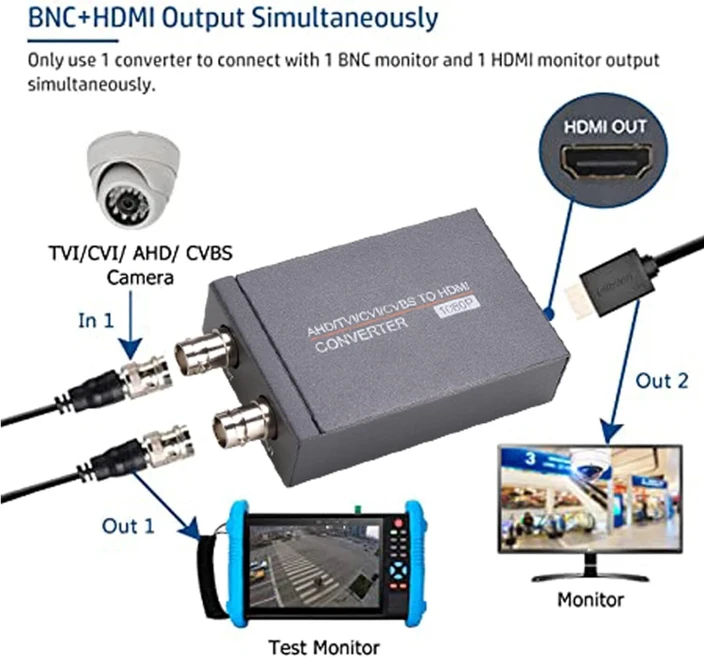
This image clearly distinguishes between a passive RF adapter (the main topic of the guide) and an active protocol converter. It shows a typical HDMI to BNC converter unit, which includes circuitry, power input, and multiple ports to handle the fundamental signal conversion between digital HDMI and analog video over coax. This visual reinforces the critical text warning that passive adapters cannot perform this function and that searching for a simple "bnc to hdmi adapter" will lead to the wrong solution.
- HDMI ↔ BNC: Digital HDMI signals can’t just “flow” into analog coax. You need an hdmi to bnc adapter box or a bnc to hdmi converter adapter that handles signal conversion.
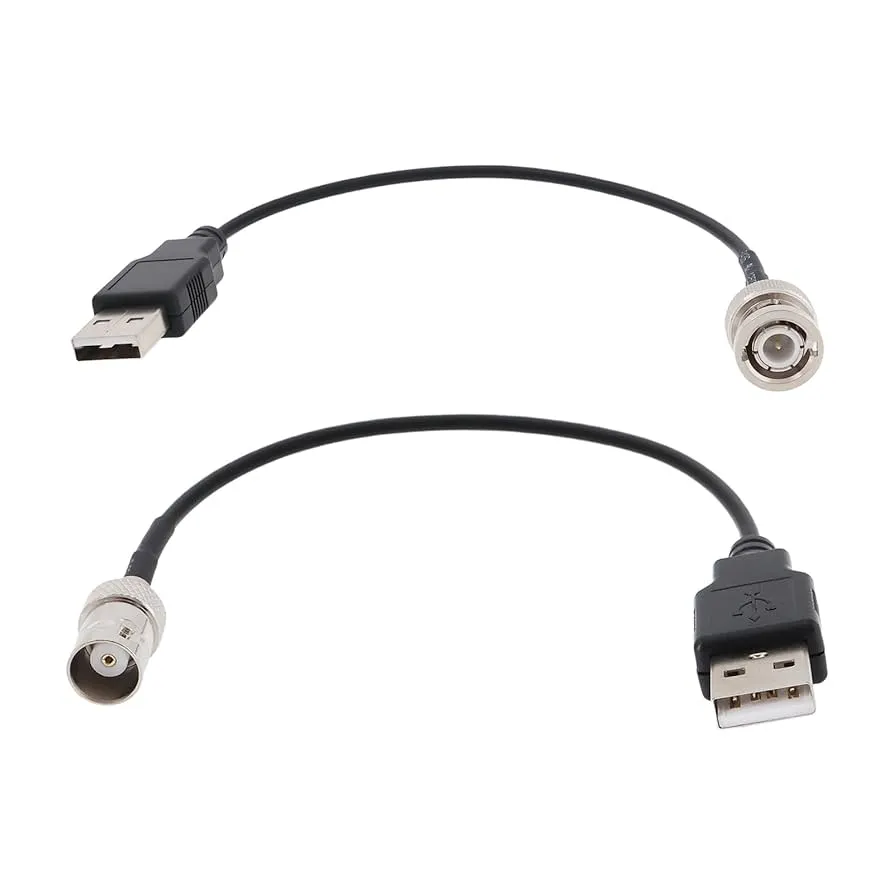
This image provides another example of an active conversion device, this time for USB to BNC. It depicts a piece of hardware that is more than just a connector; it contains the necessary electronics to translate between the USB data protocol and the signals carried over a BNC coaxial connection (often for triggering, data acquisition, or control in lab equipment). This underscores the point that USB-to-BNC connection requires an active solution, not a passive adapter.
- USB ↔ BNC: Similar story. In lab equipment, a USB-to-BNC interface always involves active circuitry. A simple barrel connector won’t work.
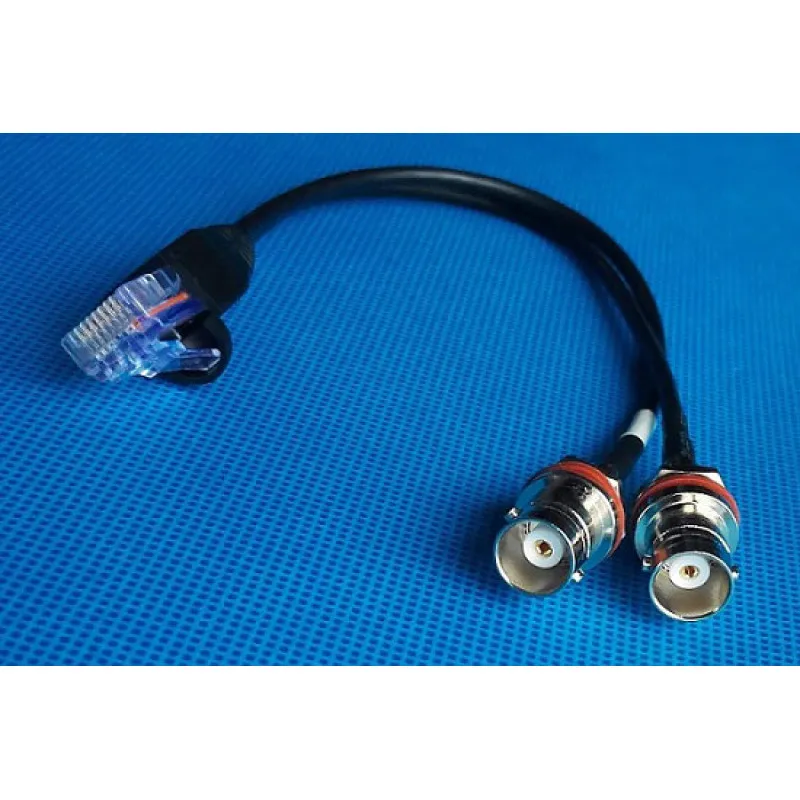
This image shows a specific type of active device called a balun, used for impedance matching and signal conversion between balanced twisted-pair cabling (Ethernet/RJ45) and unbalanced coaxial cabling (BNC). It visually supports the text explaining that a "bnc to ethernet adapter" is not a passive coupler but an active balun converter, essential for integrating modern IP cameras with legacy analog CCTV infrastructure based on coaxial cables.
- Ethernet (RJ45) ↔ BNC: This often appears in CCTV setups. A bnc to ethernet adapter or bnc to rj45 adapter is really a balun, transforming twisted-pair signals to coax.

This image depicts a specialized interface solution for video signals. Unlike a simple passive adapter, a VGA to BNC breakout typically handles the separation of the analog VGA signal into its component parts (Red, Green, Blue, Horizontal Sync, Vertical Sync) over individual coaxial cables with BNC connectors. This reinforces the text's point that even in the analog domain, connections between different video interface standards often require more than just a mechanical coupler; they need consideration of signal pinouts and impedance, embodied in a dedicated cable or adapter assembly.
- VGA ↔ BNC: Professional video monitors once used bnc to vga adapter cables, but again, those were designed with impedance and signal standards in mind, not just mechanical fit.
A quick reminder from real installs: if the product description promises to “adapt HDMI to BNC” with no power supply or circuitry, it’s almost certainly misleading. Passive connectors like the sma coax adapter or bnc connector adapter only bridge mechanical interfaces. Anything involving protocols—HDMI, USB, Ethernet, VGA—requires electronics inside.
This is why TEJTE makes a clear distinction: its SMA↔BNC adapters (JJ, KK, JK, JWK, KKY, KWK) are pure RF mechanical adapters, preserving impedance and continuity. If you’re dealing with HDMI or USB, you’re in converter territory, not coax hardware.
8) Buying Checklist
Before you click “add to cart,” it helps to slow down and run through a short checklist. Picking the right bnc adapters or sma connector adapter sets is less about luck and more about knowing your setup.
- Identify the interfaces – Do you need an SMA male to BNC female, or the opposite? Double-check both ends before ordering.
- Check impedance – Use 50 ohm bnc adapter for RF and wireless systems, 75 ohm bnc adapter for video chains. Mixing them only works in limited, low-frequency cases.
- Orientation – Straight works most of the time, but right angle sma to bnc adapter types (like TEJTE’s JWK and KWK) are lifesavers when clearance is tight.
- Panel or bulkhead install – If the adapter goes through a chassis, a bulkhead type (SMA-KKY) with a screw nut is the proper choice.
- Material and plating – Brass is economical; stainless steel lasts longer and handles frequent mating. Look for gold-plated contacts for stable conductivity.
- Single or set – For labs, it’s smart to keep a bnc to bnc adapter, a female to female bnc adapter, and several SMA↔BNC converters in one kit. That way you won’t be hunting for the missing piece mid-test.
A tip from experience: always keep at least one female-to-female coupler in your drawer. It’s the unsung hero that fixes last-minute surprises, like when two male cables end up facing each other.
By cross-checking specs—frequency rating (up to 12.4–18 GHz), working voltage (335 V), durability (500–1000 cycles)—from TEJTE’s datasheets, you’ll avoid mismatched parts and guarantee stable performance whether you’re in the lab or out in the field.
9) FAQs
What is an SMA to BNC adapter used for?
It’s the bridge between systems that don’t share a connector type. You’ll see it in labs linking test probes, in SDR setups, and in CCTV systems where SMA gear needs to mate with legacy BNC coax.
Which BNC adapter do I need (lab / CCTV / SDR)?
- In most labs: an SMA-male to BNC-female does the job.
- With SDR dongles: often an SMA-female to BNC-male is the right match.
- In CCTV: stick with 75 ohm bnc adapter types. If your gear is SMA-based, check if a 50 ohm to 75 ohm bnc adapter is necessary.
Are RCA→BNC adapters 75 Ω and when should I use them?
Yes. RCA video lines follow the 75 ohm standard, just like video-grade BNC. An rca to bnc adapter is fine for composite video, but it’s not a substitute in high-frequency RF chains.
Do PoE-to-BNC / Cat5-to-BNC adapters work?
Only with baluns. A cat5 to bnc adapter or poe-to-bnc adapter isn’t passive—it includes circuitry that adapts twisted-pair Ethernet to coax.
Can BNC be adapted to HDMI/Ethernet/USB without a converter?
No. Those are protocol-level signals. You need a bnc to hdmi converter adapter or a dedicated USB/Ethernet box. A passive connector won’t do it.
Does using SMA/RP-SMA adapters affect signal?
Slightly. A quality sma coax adapter from TEJTE introduces ≤0.15 dB loss at 6 GHz, which is negligible for most setups. But stacking multiple adapters, or mixing SMA and RP-SMA in Wi-Fi chains, can increase VSWR and lower performance.
Quick note: if your SDR suddenly shows higher noise or your video feed has ghosting, double-check the adapters. Swapping to the correct gender and impedance often clears the problem.
Conclusion
The sma to bnc adapter may look like a simple connector, but getting it right saves hours of frustration. Start by confirming the gender combination, then verify the impedance (50 Ω vs 75 Ω). After that, think about whether you need a straight, right-angle, or bulkhead type, and whether durability matters more than cost in your use case.
A good rule of thumb: fewer adapters mean lower loss. If flexibility or vibration is an issue, a short pigtail such as RG178 or RG316 may be smarter than stacking rigid adapters. For high-frequency or outdoor jobs, stainless steel housings with gold-plated contacts and silicone seals are worth the extra investment.
For engineers, labs, and integrators who need more than a one-off solution, TEJTE provides bulk packs, custom assemblies, and OEM adapter sets. Whether you’re outfitting a test bench, integrating SDR gear, or upgrading CCTV systems,
sourcing directly from a manufacturer ensures consistent specs, reliable supply, and long-term performance. Explore TEJTE’s full RF connector catalog for ready-to-ship SMA↔BNC adapters and custom solutions.
Bonfon Office Building, Longgang District, Shenzhen City, Guangdong Province, China

A China-based OEM/ODM RF communications supplier
Table of Contents
Owning your OEM/ODM/Private Label for Electronic Devices andComponents is now easier than ever.
